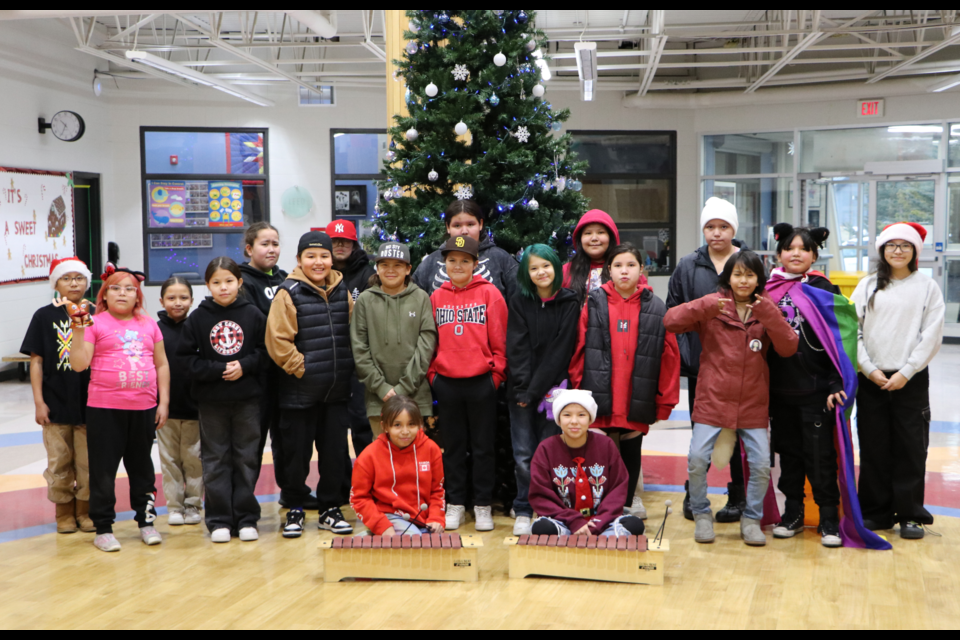ÎYÂRHE NAKODA – Move over, Drake. Nakoda Elementary School’s Grade 5 students are putting the passion in Passionfruit.
With their own spin on the Canadian rapper’s chart-topping hit, the class won the 2023 CBC Music Class Challenge and is reinvesting the $5,000 prize into more of the music technology that helped it win the contest.
“What I think we will explore more with the students is technology-based equipment," said Drew Van Allen, the school’s music teacher. "Perhaps, some software that would go along with the music program that we currently use and some mini controllers that would allow us to explore elements of DJing, which I know a lot of the kids are interested in."
The class’ submission took about a month-and-a-half to two months to complete. During that time, students used software to isolate Drake’s vocals from the song, design a melody, add a kick and shakers and plugged in a local powwow track as overlay.
All of this was accompanied by a music video and another melody the class came up with to play live with the music.
Van Allen said this generation of students is “super tech-savvy” and has picked up on music mixing technology right away.
Stockton Dixon, 10, said he gravitated toward the turntables, but also loved making beats on the xylophone.
He and classmate Zaiden Simeon, 10, said they were proud to win in their category. The MusiCounts Innovation Passion prize acknowledges diversity, technology-forward performances and showcasing cultural instruments and traditions.
“I like how we put in the powwow music,” said Dixon.
“It sounded really good. Especially the beat,” Simeon agreed.
The school’s music program is equipped with instruments like ukuleles, hand drums and xylophones, which are prominent in the music video.
Part of the prize, Van Allen added, will also be used to refurbish the school’s powwow drum that is currently out of commission.
As the music teacher explained, the hide is stretched to a frame that’s too small.
“We just need to redesign the body of the drum, and then to have one actually in the classroom that the kids could use … it just would change everything.”
Van Allen said the prize is not the motivating factor to participate – the school has entered every year since 2017 and this is its first win. However, that’s not to say the school can’t use more learning supports, especially in the arts.
A two per cent cap placed on funding increases for First Nations by the federal government in 1996 – an amount that has been found to be insufficient to keep pace with inflation and rapid increases in Indigenous populations – has led to First Nations schools receiving thousands of dollars less per student compared to spending in provincially funded schools, says the Assembly of First Nations.
The cap, put in place by former Prime Minister Jean Chrétian’s Liberal government, wasn’t lifted until after Justin Trudeau – Canada’s current Liberal prime minister – was elected in 2015. Recently, the federal government announced a promise of an extra $3.7-billion over five years for spending on First Nations education.
The federal government, which supports First Nations elementary and secondary education for eligible students living on reserve, has long been criticized for underfunding. The Truth and Reconciliation Commission recommended several calls to action in its final report to address inequities between Indigenous and non-Indigenous students in Canada, including one to publish annual reports comparing funding of First Nations students on and off-reserves, along with educational and income attainment of Indigenous peoples compared to non-Indigenous people.
In 2000, Indigenous Services Canada (ISC) committed to measuring and reporting on the education gap every two years. A 2018 report by the Auditor General indicated that, as of December 2017, the department had not met this commitment. The damning report also noted that, based on several factors, ISC’s “use of data to improve education programs was inadequate.”
In 2020, Exshaw School, which is not located on treaty land but has a small student body that is primarily from Îyârhe Nakoda First Nation, faced closure due to ISC announcing it was changing a funding agreement in place with Canadian Rockies Public Schools and Stoney Education Authority.
The agreement was ultimately renewed following outcry from the community and written support from provincial ministers but would have resulted in a decrease of about $19,000 per student to $11,000.
Van Allen said he could give “a thousand reasons why” First Nations schools need to be funded properly. More than the prize money which will help support the school, he believes the experience for students of making and sharing music is invaluable.
“I think in this situation, having the kids participate in something that’s cultural, something that’s bridging a gap between Indigenous and non-Indigenous communities and that connects people together who otherwise wouldn’t be connected; their stories being told … it sparks something really special in a lot of kids,” he said.
The Local Journalism Initiative is funded by the Government of Canada. The position covers Îyârhe (Stoney) Nakoda First Nation and Kananaskis Country.




